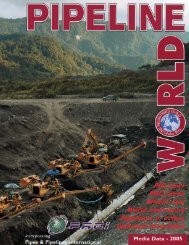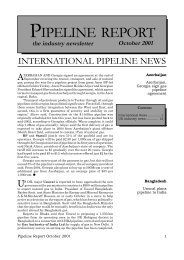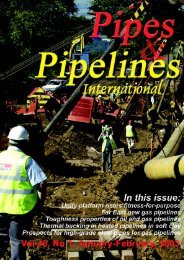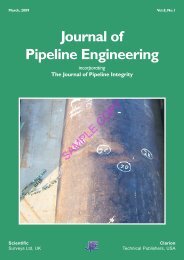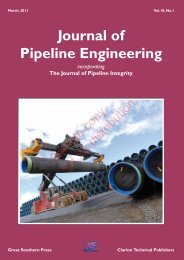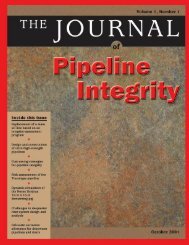JPE - Sept09 - cover2-4.pmd - Pipes & Pipelines International ...
JPE - Sept09 - cover2-4.pmd - Pipes & Pipelines International ...
JPE - Sept09 - cover2-4.pmd - Pipes & Pipelines International ...
Create successful ePaper yourself
Turn your PDF publications into a flip-book with our unique Google optimized e-Paper software.
188<br />
Specim<br />
en<br />
Maxim um<br />
strain<br />
( % ) Maxim<br />
um<br />
rotati<br />
on<br />
Foot Crest<br />
( dreg<br />
rees)<br />
pipeline operation after its regular shutdown, a rupture<br />
occurred at the foot of the wrinkle similar to the way the<br />
rupture occurred in Specimen 1.<br />
Strains and rotations<br />
As mentioned earlier, a large number of strain gauges were<br />
installed on the middle 300mm long segment of each pipe<br />
specimen to make an effort in acquiring the strain histories<br />
at critical locations of the wrinkle as wrinkle initiates and<br />
grows. The strain history for Specimen 1 is shown in Fig.5.<br />
From this figure, it can be observed that the strain at both<br />
feet of the wrinkle increased monotonically as the axial<br />
loading continued. The strain stabilized at both feet when<br />
the wrinkle came in contact from inside face of the pipe<br />
wall (Figs 3 and 5). However, for the crest, the strain<br />
increased only until when the maximum load capacity<br />
reached (point U in Figs 3 and 5). Then, the strain at the<br />
crest reduced slightly since the crest area relaxed as tension<br />
developed locally in the crest. The maximum compressive<br />
strains obtained from this specimen at the foot and at the<br />
crest of wrinkle are 13.7% and 3.6%, respectively (Table 2).<br />
It is important to note that these maximum compressive<br />
strain values were obtained from the axial load test and all<br />
the strain gauges failed and became non-functional when<br />
the wrinkle came in contact (point C in Fig.3).<br />
Inclinometers were installed on the top end plate of pipe<br />
specimens to measure the rotation that occurred during<br />
formation and growth of wrinkle. Figure 6 shows the<br />
rotation history of Specimen 1. It can be seen that the<br />
increase in rotation until initiation of wrinkle (point U)<br />
was small and it was only 0.37º. The rotation began to<br />
increase rapidly as soon as the wrinkle started to grow and<br />
the total rotation at top end of Specimen 1 reached to 3.3º<br />
until the wrinkle closed from inside pipe wall (point C in<br />
Fig.3). The change in rotation was very small once the<br />
wrinkle closed from inside pipe wall and the maximum<br />
rotation for Specimen 1 was 3.6º (Table 2).<br />
Similar behaviour in strain and rotation were also observed<br />
for Specimen 2. However, the maximum compressive<br />
strains at crest and foot of the wrinkle in Specimen 2 were<br />
4.9% and 13%, respectively. The maximum rotation at the<br />
top end of Specimen 2 was recorded at 2.8º.<br />
Maxim<br />
um<br />
load<br />
( kN)<br />
Ruptu<br />
re<br />
locati<br />
on<br />
1 13. 7<br />
3. 6<br />
3. 6<br />
1151 foot<br />
2 13. 0<br />
4. 9<br />
2. 8<br />
1176 crest<br />
Conclusions<br />
The Journal of Pipeline Engineering<br />
The following conclusions are made based on the<br />
experimental test data obtained from two tests conducted<br />
under the scope of this study. Therefore, these conclusions<br />
are limited to the pipe specimen and loading history that<br />
were applied to these two specimens.<br />
Sample issue<br />
1. Both test specimens produced wrinkle shape that<br />
look similar to the one observed in the field linepipe.<br />
Therefore, it can be concluded that the field NPS10<br />
linepipe was subjected to an eccentric axial load.<br />
The axial load might have developed due to<br />
movement of soil in the unstable slope.<br />
2. The shape of wrinkle and location of rupture of the<br />
field linepipe correlates better with those of<br />
Specimen 1. An axial load test on this specimen was<br />
undertaken in presence of internal pressure. Thus,<br />
it can be concluded that the wrinkle in field linepipe<br />
initiated and grew when it was in operation. The<br />
rupture occurred when the pipeline was being<br />
brought back to its normal operation after its<br />
scheduled shutdown.<br />
Acknowledgements<br />
This work was completed with financial assistance from the<br />
Natural Science and Engineering Research Council of<br />
Canada.<br />
References<br />
Table 2. Strains and rotations.<br />
American Standard (API), 2008. Specifications for Linepipe:<br />
API 5L. American Petroleum Institute, Washington, DC,<br />
USA.<br />
S.Das, J.R.Cheng, and D.W.Murray, 2007. Behavior of wrinkled<br />
steel pipelines subjected to cyclic axial loading. Canadian J.<br />
Civil Engineering, 34, pp 598-607.<br />
S.Das, J.J.R.Cheng, D.W.Murray, S.A.Wilkie, and Z.J.Zhou,<br />
2001. Wrinkle behavior under cyclic strain reversals in<br />
NPS12 pipe. Proc. 20th <strong>International</strong> Conference on Offshore<br />
Mechanics and Arctic Engineering, ASME, Rio de Janeiro,<br />
Brazil, pp129-138.<br />
S.Das, J.J.R.Cheng, D.W.Murray, S.A.Wilkie, and Z.J.Zhou,



